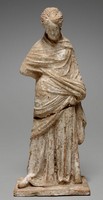Athenian potters neither invented pottery, nor the potter’s wheel, which appeared at the end of 4h millenary B.C. in the Middle East and spread over all the Mediterranean shores. But nevertheless, thanks to the quality of its clay and the skill of its potters, Athens produced for several centuries ceramics without equivalent in the Greek world.
The reign of attic ceramics starts at the end of the 7th century B.C. supplanting the corinthian production which was sold all over the Mediterranean world up to the 6th century B.C. After 550 B.C. and until the end of the 4th century B.C. the Athenian production will dominate thanks to the quality of its products, first with black figures and then with red figures.
 Black and red-figure technique
Black and red-figure technique
In the 7th century BC, ceramics produced in the city of Corinth becamen predominant on the market thanks to the invention of the black figure technique, which allowed painters to draw with a great precision on small vessels.
To achieve this, the silhouette of the characters is painted on the vase using a solution of pure clay. The painted area can be incised in order to reveal the color of the background material (lines for the eyes, the mouth, etc.). firing was performed in three steps in a furnace equipped closable vents (blowholes).
- first firing in an oxidizing atmosphere (900° C): the vents let oxygen in. The vessel becomes completely red.
- 2nd firing in a reducing atmosphere (950° C): The furnace is deprived of oxygen by closing the vents, and gets full of smoke because its heated using green wood. The pottery becomes completely black, and painted areas vitrify.
- third firing in an oxidizing atmosphere (875° C): All vents are opened, oxygen comes in, the black varnished areas remain black, while all others turn red.
The advance of Corinth did not last long: during the next century, Athens improved the black figure technique. Firing was improved, with a better contrast and brighter black figures. This technique reached its limits at the end of the 6th century BC, while a new process appears: the red figure technique, more expressive, conquers the market.
 The red-figure technique is the reverse of the black figure: the painter does not paint the characters, but covers with black varnish all the background. This invention greatly improves the painting's realism: it is no longer necessary to incise the black silhouette, just a fine brush stroke is required to show the face's expression or the musculature details accurately.
The red-figure technique is the reverse of the black figure: the painter does not paint the characters, but covers with black varnish all the background. This invention greatly improves the painting's realism: it is no longer necessary to incise the black silhouette, just a fine brush stroke is required to show the face's expression or the musculature details accurately.
The red-figure style appears in Athens about 530-520. It becomes quickly the main product in the attic workshops, and even appears as the only school during the classical period.
 Some workshops apply all the techniques: red or black figures, combination of both, or black figures on white ground.The athenian painters preferred subjects are inpired by the poems on the Trojan War, by religious scenes, but also by daily life: women in the gynecee or at the fountain, banquets and athletes at the palestre.
Some workshops apply all the techniques: red or black figures, combination of both, or black figures on white ground.The athenian painters preferred subjects are inpired by the poems on the Trojan War, by religious scenes, but also by daily life: women in the gynecee or at the fountain, banquets and athletes at the palestre.
After the defeat of the Athenians in the Peloponnesian War in 404 B.C., Attic enters a phase of decline. The potters of Magna Graecia will use this opportunity to develop their own production. The hellenistic period will however give a second breath to the art of terracotta, and especially famous are the " tanagrean" statuettes, which were first found in Tanagra, near Thebes in Béotia, but their production was undoubtedly attic. Myrina, in Minor Asia, was another production centre for those statuettes today eagerly sought after.

















